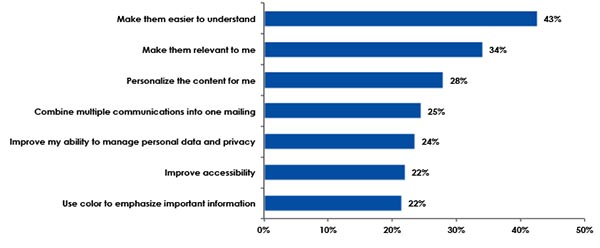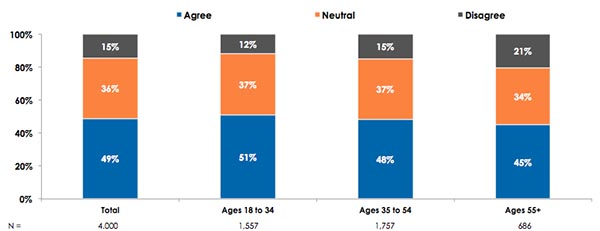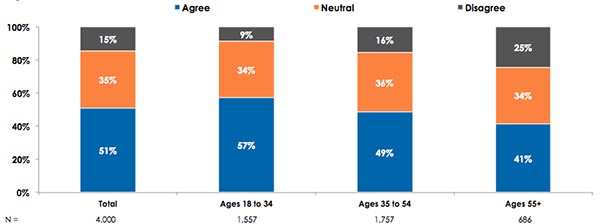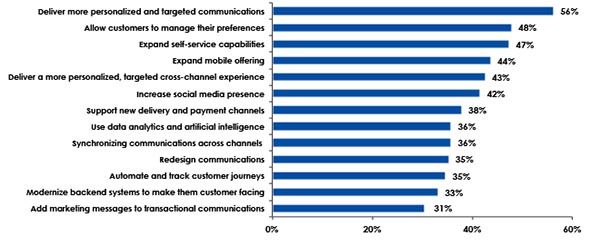- According to InfoTrends’ research, personalization is a key factor for improving transactional communications that are sent via direct mail.
- Consumers—especially younger ones—reported spending much more time reviewing direct mail and direct marketing campaigns when they were personalized and relevant.
- Nearly 32% of enterprises considered improving the customer experience as the most important business objective in their transactional communications strategy.
By Eve Padula
Introduction
At one time, the act of customer personalization simply involved incorporating the recipient’s name in various parts of a communication. Thanks to ongoing innovations in customer segmentation and data mining, today’s enterprises now have access to more information about their customers than ever before. Armed with a wealth of personal information, enterprises have the ability to create trusted one-on-one relationships with each of their customers. In parallel, consumers’ expectations are also shifting—people understand that their providers have access to a great deal of their personal information, and they now expect any communications to reflect this level of knowledge. This article explores the impact that personalization can have on the effectiveness of customer communications.
Consumers Notice Personalization!
InfoTrends’ research has consistently shown that consumers notice personalization, and it often plays a key role on how they interact with transactional and marketing communications. Earlier this year, InfoTrends conducted a survey of 4,000 consumer respondents in North America and Western Europe. Personalization was a key factor for improving transactional communications that were sent via direct mail. Over a third of respondents stated that transactional communications sent via direct mail could be improved by making them more relevant, and personalization is a critical component of relevance.
Figure 1. Personalization Improves the Effectiveness of Direct Mail
How can your providers improve the transactional communications they send via direct mail? (Top Responses)

N = 4,000 Consumer Respondents in North America and Western Europe
Source: Annual State of Transactional Communications: Consumer Survey, Keypoint Intelligence – InfoTrends 2018
According to InfoTrends’ most recent marketing communications research, about half of total respondents spent much more time reviewing direct mail and direct marketing campaigns when they were personalized and relevant. It should also be noted that younger generations were more likely to pay attention to messaging when it was personalized. This was true for direct mail as well as digital communications.
Figure 2. Consumers Spend More Time with Personalized Direct Mail
What is your level of agreement with the following statement? — “I spend much more time reviewing direct mail that is personalized and relevant to me than I do with generic direct mail.”

Base: Total Consumer Respondents in North America and Western Europe
Source: Annual State of Marketing Communications: Consumer Survey, Keypoint Intelligence – InfoTrends 2017
Figure 3. Consumers Spend More Time with Personalized Digital Marketing Campaigns
What is your level of agreement with the following statement? — “I spend much more time reviewing digital marketing campaigns that are personalized and relevant to me than I do with generic direct mail.”

Base: Total Consumer Respondents in North America and Western Europe
Source: Annual State of Marketing Communications: Consumer Survey, Keypoint Intelligence – InfoTrends 2017
Enterprises are Capitalizing on the Opportunity
Personalization clearly attracts consumers’ attention and increases their engagement. InfoTrends’ business research confirms that savvy enterprises are using the power of personalization to their advantage.
Of the 600 enterprises that participated in InfoTrends’ most recent Transactional Communications research, nearly 32% considered improving the customer experience as the most important business objective in their transactional communications strategy. Of these respondents, over half (56%) planned to improve the customer experience by delivering more personalized and targeted communications. In addition, nearly 43% intended to improve the customer experience by creating a more personalized and targeted cross-channel experience.
Figure 4. Personalization is Key to Improving the Customer Experience
How do you plan to improve the customer experience?

N = 190 Business Respondents in North America and Western Europe that consider improving the customer experience to be their most important objective
Source: Annual State of Transactional Communications: Enterprise Survey, Keypoint Intelligence – InfoTrends 2018
The Bottom Line
Today’s consumers understand that their providers have access to a great deal of their personal information, and they expect business communications to reflect this level of knowledge. Savvy businesses are learning how to leverage this knowledge to create truly personalized communications that reflect consumers’ preferences, needs, and behaviors. To deliver the best possible experience and foster loyalty, business marketers must stay informed about their customers’ changing behaviors and preferences. By incorporating an increased level of personalization, businesses can improve the customer experience by delivering more relevant and valuable campaigns. The message is clear—personalization gets noticed, increases customer engagement, and drives action!
Eve Padula is a Senior Editor/Writer for Keypoint Intelligence – InfoTrends’ Production Services with a focus on Business Development Strategies, Customer Communications, and Wide Format. She is responsible for creating and distributing many types of InfoTrends content, including forecasts, industry analysis, and research/multi-client studies. She also manages the editing cycle for many types of deliverables.














